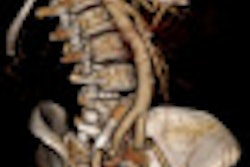The use of contrast media during CT scans significantly increases how much radiation patients absorb in amounts that vary by organ, researchers report in the June edition of the American Journal of Roentgenology. Radiologists should account for the expected dose increases when setting scanner protocols, they said.
Radiation dose increased for every organ scanned at CT, particularly in the most vascularized tissues, wrote researchers from the University of Messina in Italy. Average doses rose by one-fifth for the liver, one-third for the spleen and pancreas, and almost three-fourths for the kidneys.
"The results are in agreement with our previous data, confirming an increase in organ radiation dose in contrast-enhanced CT compared with unenhanced CT," wrote Dr. Ernesto Amato and colleagues (AJR, June 2013, Vol. 200:6, pp. 1288-1293).
Radiotherapy technique
The phenomenon of rising radiation dose in tissues and organs infused with iodine was previously studied as a potential technique for contrast-enhanced radiotherapy, and many experiments have been conducted using Monte Carlo simulations, phantom measurements, and experiments both in vivo and in vitro, wrote the study team.
Previous studies were designed to determine the dose increases in multiple CT scanner geometries and protocols. A few studies in microdensitometry, which looked at the x-ray energy spectrum emitted by the scanner's x-ray tube, also found that the mean linear energy effects were minor compared with the dose enhancement effects, they noted.
Investigators have also found an increase in the frequency of cellular abnormalities in patients who underwent contrast-enhanced radiographic examinations. But the actual increase in dose for any given scan -- which depends on iodine uptake; the shape, volume, and position of the organ; and the emitted x-ray energy spectrum -- remains unknown, the authors wrote.
Thus, the aim of the current study was to examine 40 human subjects who had undergone both unenhanced and contrast-enhanced CT covering organs that absorbed the most contrast to precisely measure the differences in absorbed radiation dose.
To determine the relationship between the iodine mass accumulated by each organ during a scan and how much radiation the organ absorbs, the researchers used a Monte Carlo simulation of an anthropomorphic phantom exposed to a simulated CT x-ray source, obtaining dose levels for the thyroid, liver, pancreas, spleen, and kidneys. Next, Amato and colleagues measured the relationship between the iodine concentration and the Hounsfield unit (HU) differences between unenhanced and contrast-enhanced tissue on a 16-detector-row scanner (Somatom Definition, Siemens Healthcare).
The 40 patients were examined on the same scanner, with contrast-enhanced CT performed immediately after unenhanced CT. All images were acquired at 120 kV, with slice thickness and reconstruction increments of 7 mm, following administration of iodinated contrast (Ultravist 300, Bayer HealthCare) during the portal phase. Differences in HU levels were determined on the images using a circular region of interest in a well-defined region of the parenchyma in both sets of CT images.
Confirming dose increases
The results were in line with the group's previous phantom study, and they confirmed significant radiation dose increases in contrast-enhanced CT versus unenhanced CT, Amato and colleagues wrote. The data showed average dose increases of 19% for the liver, 71% for the kidneys, 33% for the spleen and pancreas, and 41% for the thyroid.
"The kidneys showed the maximum among the average dose [increases] (71%, resulting from an attenuation increment of 139 HU)," the authors wrote."High renal enhancement is, in fact, due to both their high vascularization because they receive 20% to 25% of the cardiac output and the passage of iodine within the renal tubules. In particular, the level of contrast medium within renal tubules can be up to 50 to 100 times higher than that in the blood because of the mechanisms of tubular concentration and secretion."
Thyroid tissue showed the second highest dose increase (41%) after contrast injection, based on an HU increase of 87%. Also, the dose increases in the thyroid depended on tissue density on unenhanced CT, the group noted. Denser thyroids showed a lower increase in attenuation and, consequently, lower increases in dose.
Because the liver and spleen are richly vascularized, Hounsfield units increased with contrast by 49 HU and 71 HU, respectively, and average dose increased by 19% and 33%.
"It is noteworthy that, in the liver parenchyma, unlike the thyroid gland, no relationship was found between the unenhanced attenuation and radiation dose increment," Amato and colleagues wrote. "In particular, the five patients affected by liver steatosis did not exhibit a dose increment different from the average value of the other patients without steatosis."
Both the spleen and pancreas showed the same 33% average dose increase, but they derived from different Hounsfield unit increments: 71 HU for the spleen and 49 HU for the pancreas.
Amato and colleagues are considering expanding the research to other relevant organs, as well as applying the dosimetric model in other circulatory phases.
Because CT protocols often require multiple acquisitions in different phases after contrast administration, the simple, accurate method would be useful for determining the radiation dose in each organ scanned, the researchers noted.
"These data could be useful for creating new CT protocols that are tailored for different clinical problems and patient ages to obtain better diagnostic information with a lower level of radiation exposure, thus reducing the risks of cancer induction," the group concluded.



















